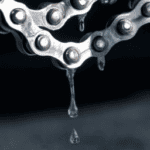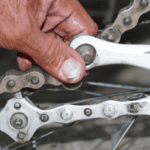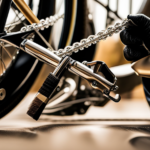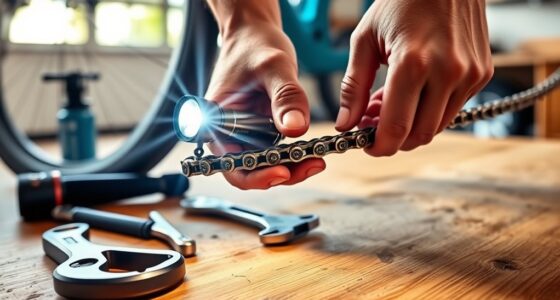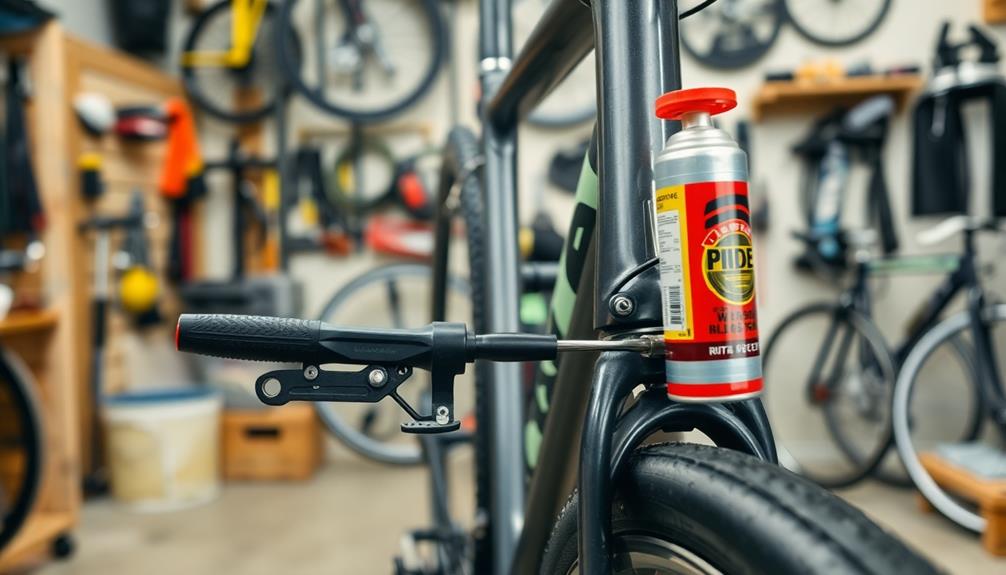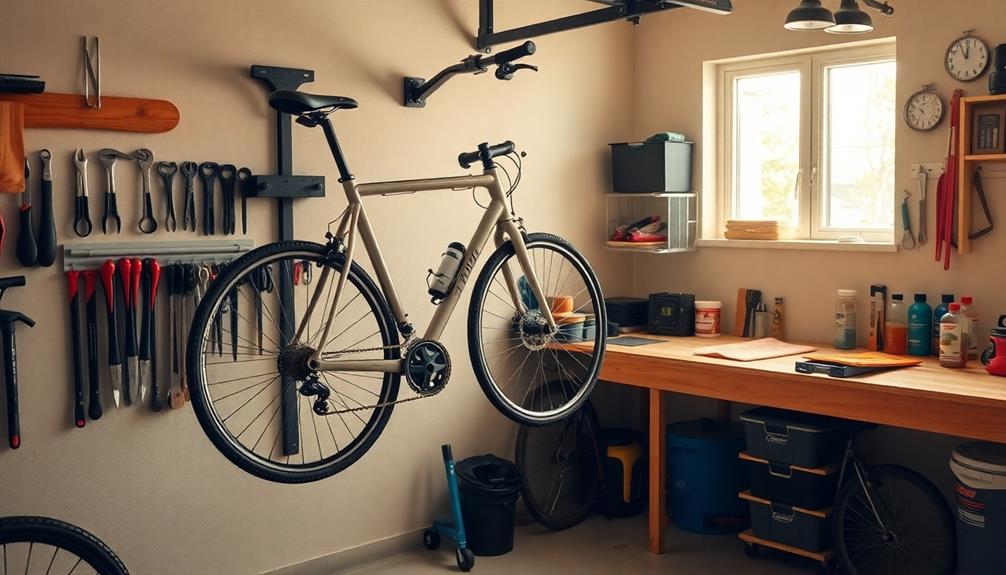To clean and lubricate your bike chain properly, start by placing your bike in a well-ventilated area and gather brushes, degreaser, and lube. Apply degreaser to the chain, scrub all sides with brushes, rinse gently, and dry thoroughly—using a rag or compressed air. Next, inspect the chain for wear and damage, then apply bike-specific lubricant to each roller while pedaling backward. Keep your chain in top shape by following these steps, and you’ll guarantee smooth rides every time.
Key Takeaways
- Use bike-specific degreaser and brushes to thoroughly clean all sides of the chain, then rinse with gentle water and dry completely.
- Inspect the chain for wear, rust, or damage; replace if multiple links are worn or if elongation exceeds 0.5%.
- Apply a small amount of chain lubricant to each roller while pedaling backward, then wipe off excess to prevent dirt buildup.
- Ensure the chain is completely dry before lubricating, and re-lubricate regularly, ideally before or after every ride.
- Check for smooth, quiet operation and secure rivets after lubrication to maintain optimal performance and prevent damage.
Preparing Your Bike and Gathering Tools
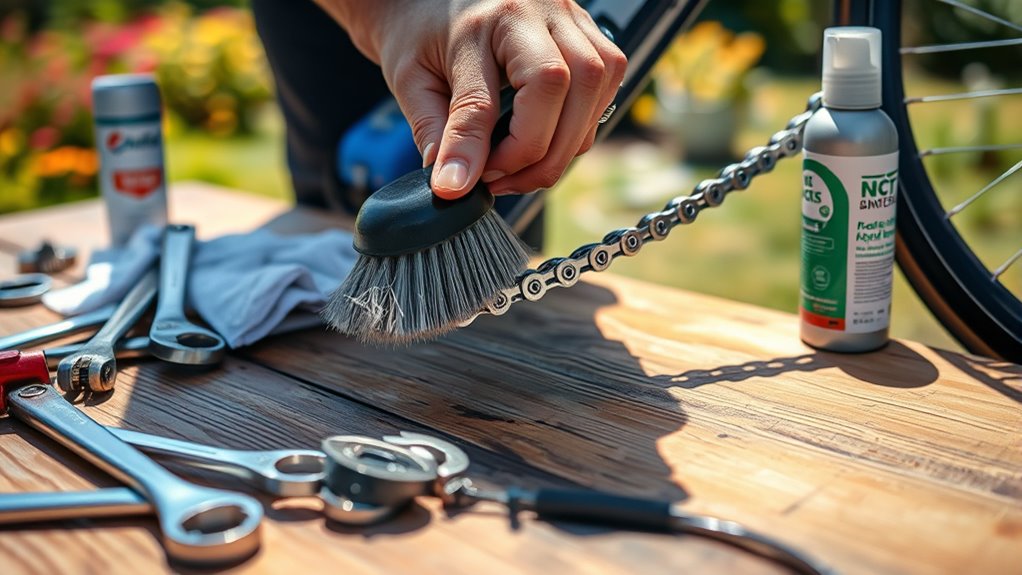
Before you begin cleaning your bike chain, it’s important to prepare your workspace and gather all necessary tools. Start by selecting a well-ventilated area outdoors or in a garage. Secure your bike on a repair stand or place it on a flat surface to guarantee stability during cleaning. Gather essential tools like brushes, rags, and degreaser—these are vital for effective cleaning. Remove any wheels or covers, such as disc brake rotors, to prevent contamination. Wear gloves and protective clothing to shield your skin from grease and chemicals. Make sure you have bike-specific lubricants ready for after cleaning. Additionally, understanding the mechanics of your bike’s drivetrain can help you perform more effective maintenance. Familiarizing yourself with the proper cleaning techniques and the types of lubricants suitable for different conditions can further enhance your bike care routine. Consulting local resources and supplies available at nearby bike shops can also ensure you have everything needed for proper maintenance. Learning about the benefits of regular cleaning and lubrication can motivate consistent upkeep. Implementing advanced cleaning methods can help remove stubborn dirt and extend your bike’s lifespan. With everything in place, you’ll be ready to proceed efficiently, keeping your bike in top condition and ensuring a smooth, thorough cleaning process.
Degreasing and Cleaning the Chain

To effectively degrease and clean your bike chain, start by applying a bike-specific degreaser directly onto the spinning chain or using a chain-cleaning device filled with degreaser. This loosens dirt and grime embedded between links and rollers. Use a stiff-bristled brush or a dedicated chain cleaning tool to scrub all sides thoroughly, ensuring you remove grime from every crevice. After scrubbing, rinse the chain with water or wipe it down with a damp clean rag to eliminate residual degreaser and loosened debris, but avoid high-pressure water that can force dirt into bearings. Once clean, dry the chain completely with a clean rag or compressed air to prevent rust formation. Proper drying prepares your chain for lubrication, ensuring smooth operation and longevity. Additionally, paying attention to lubrication techniques will help maintain your chain’s performance and prevent premature wear. Regularly inspecting and cleaning your chain is essential for optimal bike performance and equipment longevity.
Rinsing and Drying the Chain
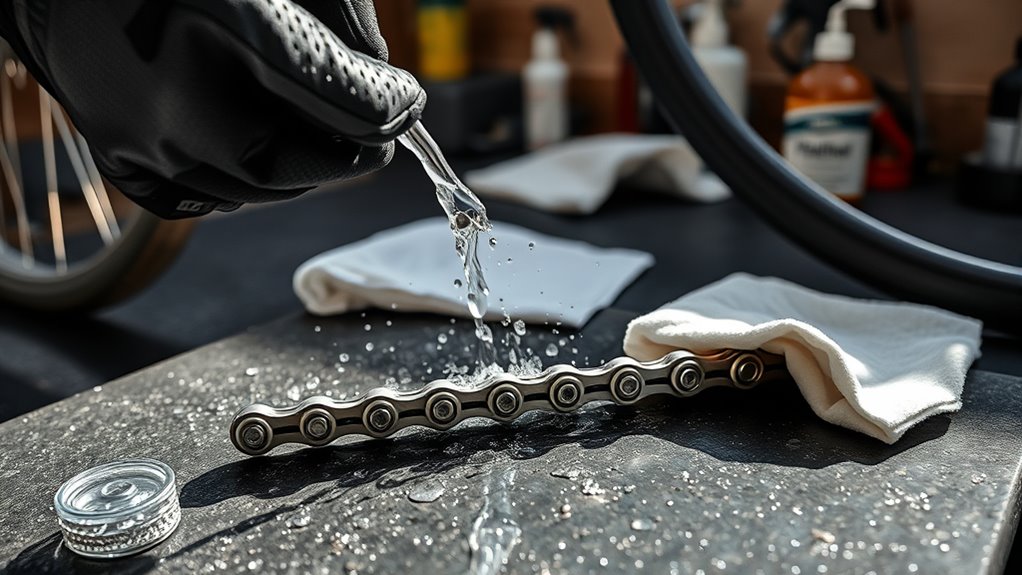
After scrubbing your chain, it’s important to rinse it thoroughly to remove any remaining degreaser and dirt. Use a gentle spray or sponge and avoid high-pressure water on bearings or hubs to prevent damage. Once clean, let the chain air dry in sunlight or wipe it dry, ensuring it’s completely dry before applying lubricant. Additionally, ensuring the lubrication process is performed correctly will help maintain optimal performance and prevent premature wear. Proper drying also helps avoid the buildup of moisture that can lead to rust and corrosion, which can compromise the integrity of your bike chain. Using a quality lubricant specifically designed for bike chains can further enhance protection by forming a barrier against moisture and dirt, extending the life of your chain.
Effective Water Rinsing Techniques
When rinsing your bike chain, use a gentle stream of lukewarm water from a hose or sponge to effectively remove soap and debris without risking water intrusion into bearings. This rinsing method helps dissolve residual grease and dirt, ensuring a thorough clean. Be careful to avoid high-pressure sprays, which can force water into bearings and cause damage. After rinsing, dry the chain completely with a clean rag or compressed air to prevent moisture from lingering. Allowing the chain to air dry in sunlight for 10-30 minutes also helps evaporate residual moisture, reducing rust risk. Proper rinsing techniques are essential for keeping your chain clean and protected against corrosion. Incorporating water management practices further ensures that moisture doesn’t lead to premature wear. Additionally, using water-resistant lubricants can help protect your chain from moisture and extend its lifespan. Applying a proper lubrication after cleaning helps maintain smooth operation and prevents rust formation. To further safeguard your chain, consider applying corrosion inhibitors, especially in humid or rainy conditions.
Proper Chain Drying Methods
Once you’ve rinsed your bike chain with lukewarm water and removed soap and dirt, it’s important to dry it thoroughly before applying lubricant. Use a clean rag to wipe off excess moisture and prevent rust formation. For a more complete dry, you can use an air compressor to blow out water from inside the links, especially after applying a degreaser on the chain. Avoid high-pressure water directly on the chain, as it can push water into bearings. Allow the chain to air dry in sunlight for at least 30 minutes to facilitate evaporation. Automation technologies can also assist in drying processes to ensure no residual moisture remains. To further protect your chain from corrosion, consider applying a specialized bike chain protector after drying. For optimal chain longevity, always ensure the chain is completely dry before lubrication. Once the chain is dry, you can safely apply a dry lube or other preferred lubricant. Ensuring the chain is fully dry helps prevent corrosion and promotes smooth, long-lasting performance. Additionally, choosing a water-resistant lubricant can provide extra protection against moisture in future rides.
Inspecting the Chain for Wear and Damage
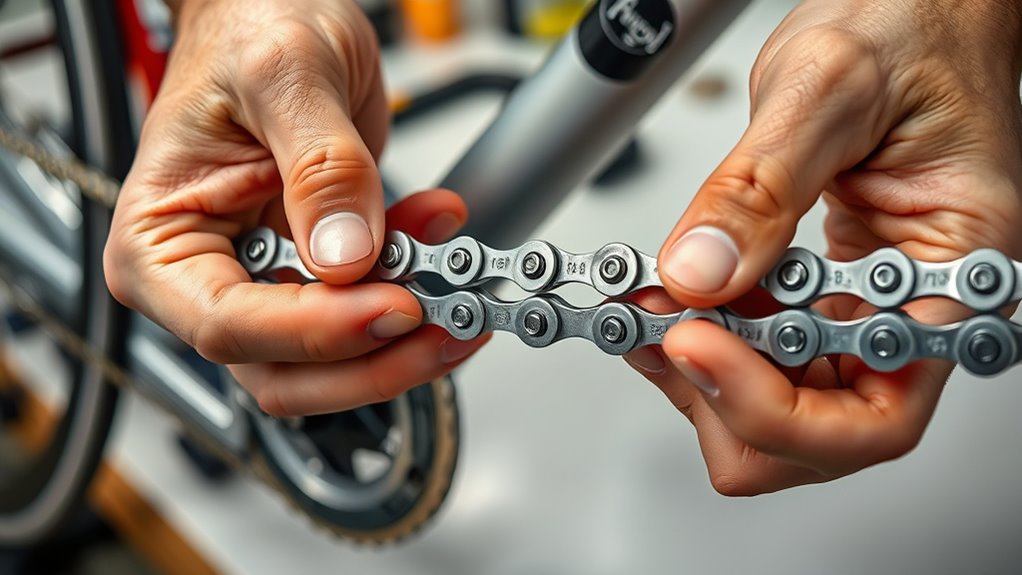
Start by checking your chain for elongation with a chain wear gauge; if it drops into the links or shows over 0.5%, it’s time to replace it. Next, examine individual links for rust, corrosion, or stiff movement to spot potential issues early. Finally, inspect rivets and pins for wear or looseness that could compromise your chain’s strength. Regular maintenance of your bike chain also helps prevent damage to internal components and ensures optimal performance.
Check for Elongation
Regularly checking your bike chain for elongation is essential to maintaining smooth and safe riding. Use a chain-checker, like Pedro’s Chain Checker Plus II, to measure wear accurately. Insert the prongs into the chain links; if prong C drops in, the chain has approximately 0.5% to 0.75% elongation and needs replacing. Measure the chain at multiple points to ensure even wear—localized elongation could signal damage. Avoid riding with a worn chain, as it causes gear skipping, poor shifting, and increased stress on the drivetrain components. Keep an eye on these signs to prevent unnecessary damage and costly repairs. Regular inspection helps you determine when to replace the chain, guaranteeing peak performance and longevity for your bike.
Examine Link Integrity
To guarantee your bike runs smoothly, it’s important to examine the integrity of each link in the chain. Start by inspecting individual chain links for link wear, stiffness, or tightness, which can indicate chain damage. Gently bend each link back and forth to check for stiff links, signaling potential issues. Use a chain gauge to measure elongation; if the Prong C drops into the links, replace the chain. Examine rivets and pins for signs of elongation, cracking, or looseness, which weaken the chain. Look for rust, corrosion, or pitting on links, rollers, and pins, as these weaken the structure. If multiple links show wear or the chain exceeds the manufacturer’s elongation limits, it’s time to replace the entire chain to prevent further damage.
Applying Proper Lubrication

Applying proper lubrication is essential for keeping your bike chain running smoothly and extending its lifespan. To do this, use a small drop of chain lube directly onto each roller while slowly pedaling backward, ensuring even coverage. After applying, wipe off any excess lube with a clean rag to prevent dirt and grime from sticking. Opt for a drip-on lubricant rather than spray to better control application and avoid overspray on brake rotors or rims. Regularly re-lubricate the chain after cleaning and drying, ideally before every ride or every second ride in dirty conditions. During application, inspect the chain for tight links or damaged rivets to catch potential repair needs early.
- Use the correct type of chain lube for your riding conditions
- Avoid over-lubricating to prevent attracting dirt
- Use a clean rag to remove excess lube after application
- Re-lubricate regularly for ideal performance
Final Checks and Maintenance Tips
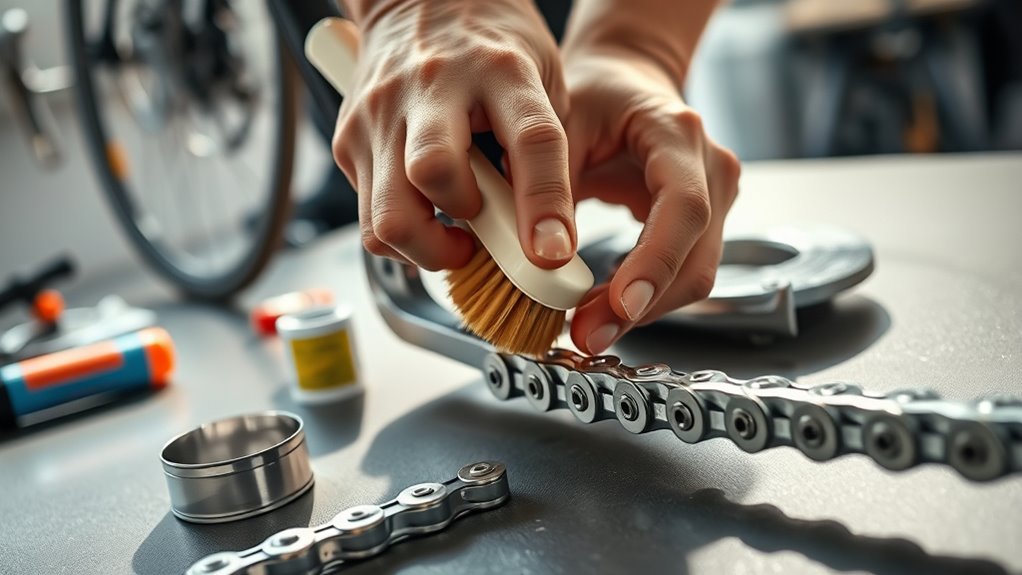
Once you’ve finished cleaning and lubricating your bike chain, it’s important to perform final checks to guarantee everything operates smoothly. Use your free hand to rotate the pedals backward, ensuring the chain moves freely and quietly. During your final inspection, look for signs of wear by using a chain-wear gauge; replace it if needed. Confirm that the quick-link or master rivet is secure, and the chain runs smoothly through the drivetrain. Wipe off any excess lubricant to prevent dirt buildup, which can cause drivetrain issues. Also, inspect for rust and corrosion, as these can weaken your chain and lead to more significant problems. Regular final checks help prolong your chain’s lifespan and keep your bike shifting effortlessly.
Frequently Asked Questions
Is It Better to Wax or Oil Bike Chains?
When choosing between wax and oil for your bike chain, it depends on your riding conditions. Wax chains attract less dirt, stay cleaner, and run quieter, making them ideal for dry, clean environments. Oil lubricants penetrate deeper and are better for wet, muddy conditions, but need more frequent reapplication. Consider your terrain and maintenance preferences to decide which option suits you best.
Is It Okay to Use WD-40 on a Bike Chain?
Using WD-40 on your bike chain is like spraying water on a waxed car; it might loosen dirt temporarily but doesn’t protect or lubricate. You might think it’s okay, but it strips away existing lubricant and exposes your chain to moisture, leading to rust and faster wear. Instead, you should use bike-specific lubricants that stick, protect, and keep your chain running smoothly mile after mile.
Should I Lube My Bike Chain After Every Wash?
You should definitely lube your bike chain after every wash. This helps prevent rust, reduces wear, and keeps your chain running smoothly. Even if it looks clean, applying lubricant restores the protective film that moisture and dirt can strip away. Just remember to wipe off excess lube so it doesn’t attract dirt. Regular lubing, especially after wet rides, extends your chain’s lifespan and improves your riding efficiency.
Should You Lubricate the Inside or Outside of a Chain?
You should focus on lubricating the inside of your bike chain. Apply the lubricant directly to the rollers and pins while rotating the pedals to help it penetrate fully. This reduces internal wear and friction. Afterward, wipe off any excess from the outside to prevent dirt buildup. This method keeps your chain well-lubricated internally and clean externally, ensuring smoother riding and longer chain life.
Conclusion
Regularly cleaning and lubricating your bike chain not only extends its lifespan but also guarantees smooth rides and better performance. By following these simple steps, you prevent rust and reduce wear, saving you money in the long run. Some cycling enthusiasts believe a well-maintained chain can even boost efficiency, making your rides feel effortless. So, take a little time for maintenance—you’ll enjoy a faster, quieter ride and keep your bike in top shape for miles to come.





